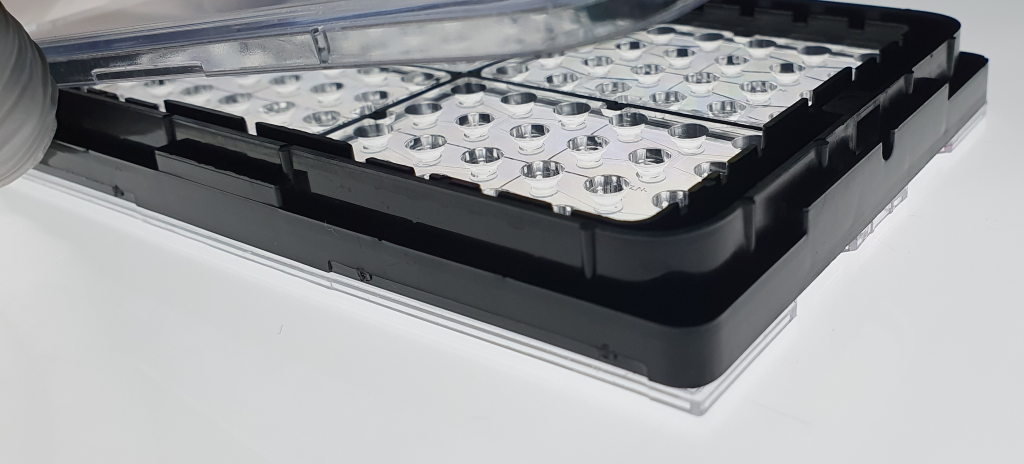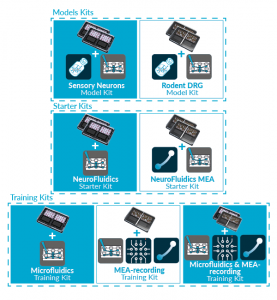MICROFLUIDICS IS NOW JUST
1-CLICK AWAY WITH NETRI SHOP
Discover our new exclusive package
organs-on-chip kits and all our
neuro-organs-on-chip devices.

Over the past decade, no molecule tested in clinical trials to slow or cure neurodegenerative diseases has been brought to market. Alzheimer’s disease (AD) is the most common neurodegenerative disease, leading to decline in memory, cognition, and ultimately all brain functions. Development of new therapies for AD is indeed a real challenge with high failure rates and long development times. Many factors have been contributing to this global failure of clinical trials including poorly understood etiology and physiological differences between species, leading to a lack of translational preclinical models. A growing body of evidence suggests that oligomeric forms of amyloid beta (AβO) and Tau (TauO) play key roles in the physiopathology of AD. These oligomers are the predominant neurotoxic species in brains during the early stages of AD and provide a suitable effective target to treat it.

An essential first step towards the development of innovative organs-on-chip (OoC) models of Alzheimer's disease has been taken. The NeuroFluidics Devices are helping to elucidate the underlying mechanisms of the disease and the search for effective new therapies.
• DuaLink MEA or DuaLink Shift MEA NeuroFluidics Devices & CNS NeuroFluidics Cultures
• Compartmentalized co-culture of hiPSC-derived glutamatergic (channel 1) and GABAergic neurons (channel 3) to create a reference model of the pathology
• Addition of ETAP-Lab's oligomeric forms of amyloid beta1-42 (AβO) in channel 3 to create an altered model of the pathology
The use case demonstrates (i) a compartmentalized and fluidically isolated co-culture of hiPSCs-derived glutamatergic and GABAergic neurons in DuaLink as a healthy model and (ii) a primary rodent neurons cell culture with the addition of the AβO oligomer of ETAP-Lab as an altered model.
• Fully characterization of the neuronal populations, using a wide variety of readouts (immunoassay, immunostaining, and electrophysiological activity)
• Characterization of the AβO oligomer by various biophysical methods
• Induction of dose-dependent neurotoxicity in vitro
Test your compound on our ready-to-use NeuroFluidics Cultures with reference compound already on the market or having failed in the clinical phase.

An essential step to elucidate the mechanisms underlying the pathology and screen for effective new therapies.
• Relevant & industry-standard models
• Standard operating procedure for co-culture of human glutamatergic and GABAergic neurons
• Protocol for induction of AβO lesions with rodent cells and hiPSC-derived neurons (in progress)
NeoBento™, the standard format for NeuroFluidics Devices chips, available up to 4 QuarterBentos™ (up to 16 chips).
• Standard ANSI format (96-well plate)
• Pump-free & expensive equipment-free
• Standard equipment (liquid handling & imaging) compatibility
This culture enables a complex neuropathological phenomena to be finely reproduced.
• New model for preclinical studies
• Fully differentiation and maturation of human neurons-on-chip
• Control of cell seeding density, homogeneity and media exchange
In-depth reading of the data to better understand the study results and potential implications.
• Electrophysiological recording (MEA)
• Imaging (Immunofluorescence, Calcium Imaging…)
.
• Biochimic analysis (ELISA, Lysis cells analysis, Liquid Chromatography…)
• Technological Transfert
• FTE & Screening Services
• Co-development
• Analytical Services
• NeuroFluidics Devices
• NeuroFluidics Cultures
• NeuroFluidics Digital
• Training & Organs-on-chip Kits
Discover our new exclusive package
organs-on-chip kits and all our
neuro-organs-on-chip devices.

ORGANS-ON-CHIP KITS
Quickly and easily adopt organs-on-chip
into users’ research

